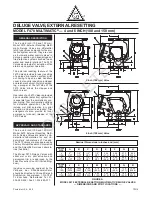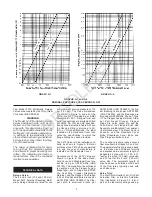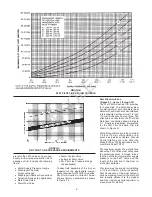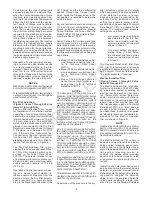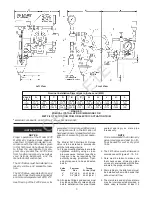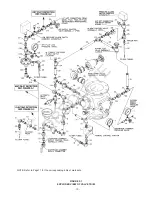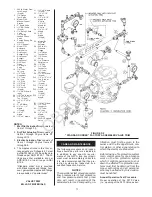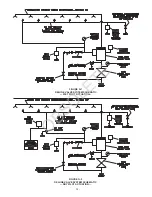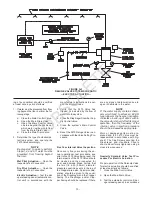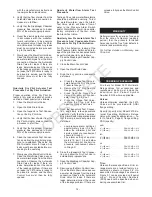
To determine the most hydraulically
demanding location of a wet pilot line,
when the choice between two or more
locations is not readily apparent, de-
termine for each location the elevation
above the F470 Valve and the equiva-
lent length of fittings plus horizontal
pipe from the F470 Valve to the loca-
tion. Then, using Graph B, determine
the minimum system supply pressure
required for the elevation and equiva-
lent length of pipe at each location.
Interpolate between the equivalent
length plots as necessary. The location
requiring the highest system supply
pressure is the most hydraulically de-
manding location for the wet pilot line.
(Reference: In no case should the re-
quired system supply pressure exceed
the actual available minimum expected
system supply pressure.)
Operation of a pilot sprinkler or open-
ing of a manual control station results
in a rapid pressure drop in the Dia-
phragm Chamber of the F470 Valve,
and the force differential applied
through the Clapper Latch which holds
the Clapper down in the set position is
reduced to below the valve trip point.
NOTES
Wet Pilot Lines must be maintained at
a minimum temperature of 40°F/4°C.
It is recommended that internally gal-
vanized pipe and cast iron fittings be
used for wet pilot lines.
Dry Pilot Actuation
(Figure F, Items 1 through 35 plus
Items D1 through D14)
The Dry Pilot Actuation Trim provides
for installation of a detection system
consisting of dry pilot sprinklers (heat
detectors) and manual control stations
interconnected with minimum 1/2 inch
(15 mm) steel pipe. The pilot line,
which is to be pressurized with air or
nitrogen, is connected to the “Dry Pilot
Detection” connection shown in Figure
F. Provision must be made for a 1/2
inch (15 mm) orifice, Inspector’s Test
Connection at the most remote loca-
tion from the F470 Valve. Nominal in-
stallation dimensions for Dry Pilot Ac-
tuation Trim are shown in Figure E.
The Dry Pilot Actuation Trim is pro-
vided with a listed and approved Model
B-1 Dry Pilot Actuator, which is de-
scr ibed in Technical Data Sheet
TD117W. The Actuator is rated for use
at a maximum pilot service pressure of
50 psi (3,4 bar) and a maximum water
supply service pressure of 175 psi
(12,1 bar).
Operation of a pilot sprinkler or open-
ing of a manual control station, re-
leases pneumatic pressure from the
pilot line. In turn, the Dry Pilot Actuator
opens resulting in a rapid pressure
drop in the Diaphragm Chamber of the
F470 Valve, and the force differential
applied through the Clapper Latch
which holds the Clapper down in the
set position is reduced to below the
valve trip point.
Dry pilot sprinklers are to be minimum
1/2 inch (15 mm) orifice listed or ap-
proved automatic sprinklers. Manual
Control Stations are to be either the
Model F180 or F184 described in Tech-
nical Data Sheet TD121.
Graph C shows the “minimum pilot line
service pressure” as a function of the
water supply pressure. The pressure in
the dry pilot actuation system must be
automatically maintained using one of
the following maintenance devices, as
appropriate.
•
Model F324 Air Maintenance De-
vice (pressure reducing type), re-
fer to Technical Data Sheet
TD111.
•
Model F326 Air Maintenance De-
vice (compressor control type), re-
fer to Technical Data Sheet
TD112.
•
Model F328 Nitrogen Mainte-
nance Device (high pressure re-
ducing type), refer to Technical
Data Sheet TD113.
NOTES
The dew point of the pilot line air
pressure must be maintained below
the lowest ambient temperature to
which the dry pilot actuation system
will be exposed. Accumulation of
water in the pilot line connection to
the Actuator will lower the air pres-
sure at which the Actuator will open
and possibly prevent proper opera-
tion. Also, introduction of moisture
into the pilot lines exposed to freezing
temperatures can create an ice
buildup which could prevent proper
operation of the Actuator.
An air dryer must be installed where
the moisture content of the air supply
is not properly controlled at less than
the required value. The desiccant
dryer with mounting accessories de-
scribed in Technical Data Sheet
TD135 is suitable for use with a maxi-
mum inlet pressure of 150 psi (10,3
bar) and for drying system air down
to a dew point of less than -20°F/-
29°C at a pressure of 45 psi (3,1 bar).
It is recommended that an F328 Ni-
trogen Maintenance Device be utilized
in dry pilot actuation system applica-
tions where the dew point must be
maintained below -20°F/-29°C. See
Technical Data Sheet TD113.
It is recommended that internally gal-
vanized pipe and cast iron fittings be
used for dry pilot lines.
Supervision of the pressure in the dry
pilot actuation system and/or alarm
which separately indicates operation
of the detection system is recom-
mended and may be required by the
authority having jurisdiction. A dual
setting low pressure alarm switch,
such as the unit described in Technical
Data Sheet TD210, is suitable for the
service. The recommended pressure
settings are as follows:
•
Low pressure alarm setting at
approximately 6 psi (0,4 bar)
below the minimum pilot line
service pressure requirement
shown in Graph C.
•
Fire alarm setting at approxi-
mately 15 psi (1,0 bar) below
the minimum pilot line service
pressure requirement shown
in Graph C.
The Pressure Relief Valve (Ref. Item
D5 - Fig. F) is factory set to relieve at
a pressure of approximately 45 psi (3,1
bar); however, it may be field adjusted
to a lower pressure, if required.
Electric Actuation Trim
(Figure F, Items 1 through 35 plus
Items E1 through E5)
The Electric Actuation Trim is required
for electric operation of the F470 Valve
by a detection system consisting of
electrical devices such as heat sensi-
tive thermostats, smoke detectors,
and/or electric manual pull stations.
Information on the various types of So-
lenoid Valves that may be used with
this trim package is given in Technical
Data Sheet TD119. A listed and ap-
proved, 24VDC Solenoid Valve for
non-hazardous locations is supplied
as standard. Nominal installation di-
mensions for the Electric Actuation
Trim are shown in Figure D.
NOTE
Approval by Factory Mutual is contin-
gent on the use of an FM Approved
24VDC Solenoid Valve. FM only ap-
proves solenoid valves for use in non-
hazardous locations.
The Electric Actuation Trim is only to
be used in conjunction with an electric
deluge valve releasing panel (auto-
matic control unit) that is listed or ap-
proved (as appropriate) for fire protec-
tion system releasing ser vice. In
addition, the deluge valve releasing
panel is only to be operated by listed
or approved (as appropriate) fire de-
tectors.
Operation of an electrical device such
as a heat sensitive thermostat, smoke
detector, or electrical manual control
station signals the deluge valve releas-
ing panel to energize the Solenoid
Valve. In turn, the energized Solenoid
Valve opens resulting in a rapid pres-
sure drop in the Diaphragm Chamber
-5-
OBSOLETE

